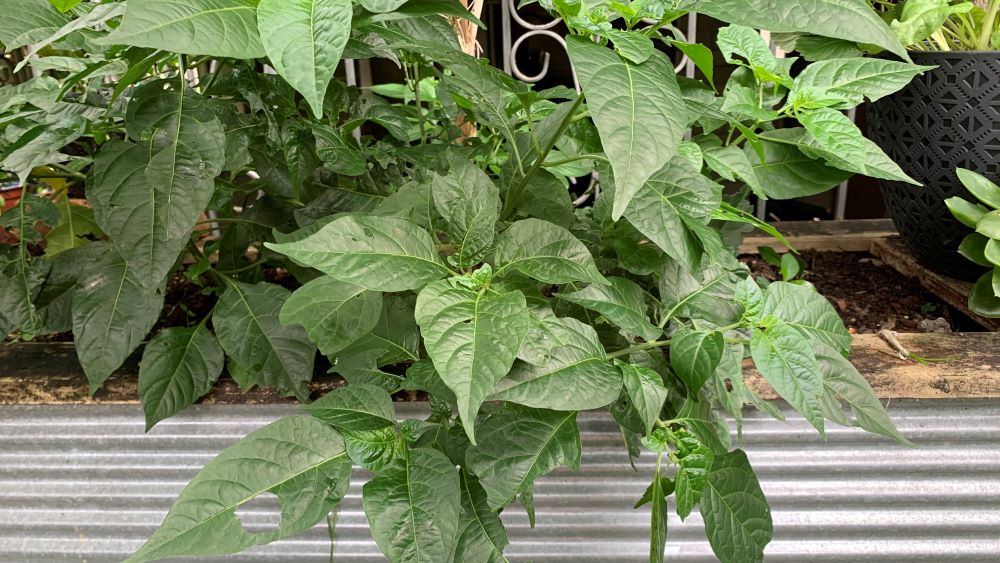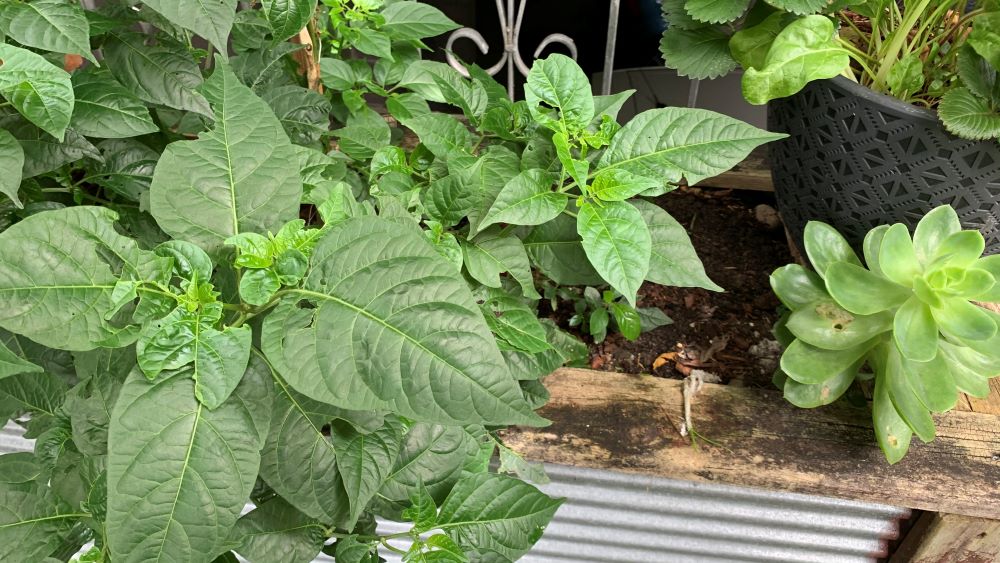Pepper plants leaves can turn light green due to a lack of nitrogen, overwatering or a lack of sunlight. Prepare the soil before planting peppers with compost, aged manures and pelleted chicken manure to add nitrogen to the soil. Plant peppers in a full sun position and water the plants when the soil has dried 2 inches below the surface.
Peppers love warm, summer sun and need bright light and nitrogen to develop deep green leaves. Nitrogen and sunlight are needed for the plant to develop chlorophyll in their leaves giving them their green color. Chlorophyll is needed for the plant to photosynthesize turning sunlight into carbohydrates for stem growth and to feed the plant.

This article will explore the top reasons why pepper leaves turn light green and easy solutions to green up your pepper plants.
This year I am growing habanero peppers which are growing strong and dark green using these easy tips.
Top 3 causes of light green leaves on pepper plants
Here are the top 3 causes of light green leaves on pepper plants. Check out each one to see if they are the cause of the problem for your pepper plants.
1. A lack of nitrogen
Nitrogen is needed for the plants to develop deep green leaves. A lack of nitrogen or nitrogen deficiency can cause the plant leaves to become pale, light green and eventually yellow. Plants that lack nitrogen in the long term will have stunted growth, less leaf coverage and will not produce as well over the season.
A lack of nitrogen can be caused by planting into poor soil, choosing a potting mix without a slow release fertilizer or overwatering.
Fix this problem by giving your plants a dose of liquid nitrogen fertilizer. Repeat in 2 weeks and then add a handful of pelleted chicken manure. Water it in well and this will return nitrogen to your soil. You should see your pepper plant turn a darker green over a 3-4 week period if nitrogen was the problem.
2. Overwatering
Pepper plants that are overwatered can turn a light green color. Overwatering will wash nitrogen out of the soil and can compact the soil reducing the oxygen levels. Overwatering can eventually lead to root rot, a fungal growth on the roots that stops the plant from absorbing nutrients.
Peppers like regular water but too much can damage the soil, plant roots and leaves. Start by checking the soil before watering until you work out the right schedule for your climate.
I water my peppers twice per week in summer because I live in a sub-tropical area with high rainfall. Always surround your peppers with mulch to reduce evaporation from the soil and to keep the soil more consistently moist.
Mulch can also help to protect plants from overwatering as it absorb the extra rainfall and slowly releases it into the soil.
3. Lack of sunlight
Pepper plants like long summer days to thrive and grow dark, green leaves. Plants need sunlight to develop the chlorophyll in their leaves which gives them their green color. A lack of sunlight can lead to pepper plants that grow long, leggy with light green leaves.
Their stems can stretch up high reaching out for light and their leaves will become pale.
Plant peppers in full sun to allow them to develop a good amount of chlorophyll in their leaves. They ideally need at least 6 hours of sunlight but more is better. A full day of sun will give you healthy, deep green leaves and lots of peppers over summer.
How to green up pepper plants
If your pepper plant has pale leaves or you want to prevent this problem, check out these easy tips to green up pepper plants.
1. Prepare the soil first
Before planting out new pepper plants always take the time to improve the soil with good quality organic matter. This will make sure there is plenty of nitrogen for good plant growth.
Start by mixing in up to 1/3 of the soil mix with compost, aged manure and worm castings. A combination of these three ingredients will add a range of nutrients, aerate the soil and ensure that the plant has good drainage.
Mix these ingredients through the top 12 inches of soil and allow it to rest for 2-4 weeks before planting your new peppers.

2. Top dress with compost and aged manure
For peppers that are already growing in the ground, top dress them with a mix of aged manure and compost. Layer this mix 1 inch thick over the root zone of the peppers. Top this with a 2-3 inch layer of mulch. This will keep the moisture in the soil and fertilize the plant as it is watered.
3. Water regularly
Watering peppers regularly is essential to make sure they grow well, absorb the nutrients they need and are healthy enough to grow fruit.
4. Mulch your soil
Mulch your pepper plants with a light mulch such as sugar cane, straw, lucerne or hay. This will help to keep moisture in the soil for longer, feed the worms and soil bacteria and protect the plant roots.
5. Feed pepper plants with pelleted chicken manure to return nitrogen
To make sure that pepper plants are fed with pelleted chicken manure at the start of spring. Feed with them pelleted chicken manure around 4 weeks after planting to give them an extra boost. This will give the plant plenty of nitrogen to establish but is still a light, natural fertilizer that won’t overdose the plant with food.
If you are getting too many leaves, stop adding fertilizer and water the plant well over time it will use up the nitrogen and will start to produce flowers. You can top it up with a flower and fruit promoting fertilizer in late summer if you still don’t have peppers.

Pepper Plant Leaves Turning Light Green | Summary
Pepper plant leaves will turn light green due to a range of factors that you can quickly solve. More sun, regular water and adequate nitrogen are important for pepper plants to make sure their leaves develop a deep green color, photosynthesize effectively and grow strong.
Pepper plants are highly productive and can actually stay healthy and grow throughout the year in mid climates.
Happy growing.
I am an accredited practicing dietitian, experienced gardener and a dedicated cook. I love writing and sharing my experience so you can learn from my successes and mistakes.
